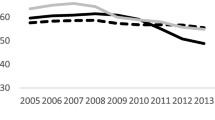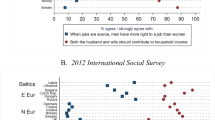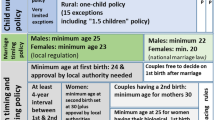Abstract
The existing literature on welfare effects on marriage and fertility has largely focused on groups of white and black women. By contrast, Hispanic women have received little attention. This paper examines the effects of welfare generosity on a sample of young Hispanic women’s premarital fertility and marriage choices. A bivariate competing risks duration model framework allows us to identify the process of young women’s premarital fertility and the process of marriage, effectively controlling for observed characteristics and unobservables. Our findings indicate a 10% increase in welfare generosity results in a 10% increase in premarital births and a 7% decrease in marriages by age 24; both effects are significant.
Similar content being viewed by others
Notes
Blank (2002) provides a review of more recent literature, including studies examining the impact of welfare reform on female headship.
No women in our sample had a child before age 13.
Moffitt et al. (1998) analyze the extent of cohabitation among welfare recipients. They find that a significant proportion of single mothers cohabitate. Our results are consistent with their findings since we focus our attention on young women at the time of their first premarital birth while their sample includes all single women.
The test measures arithmetic reasoning, word knowledge, paragraph composition, and numeric operations. It was administered to most of the subjects in the NLSY and is commonly used as a measure of unobserved ability.
This measure of welfare is defined in Moffitt (1994) page 626, footnote 12. Like Moffitt, we did not find significant differences when using the AFDC variable instead of Moffitt’s index of welfare generosity.
Cameron and Trivedi (2005, chapters 17–19) provide a good textbook treatment of the hazard rate or survival models, including competing risks and economic applications.
We find that the large set of variables explains more than the small set. Taking into account that competing risk models are highly nonlinear, one possible explanation is that the large set of explanatory variables explains some confounding effects in the marriage and fertility processes and this allows for a more precise estimate of welfare effects.
References
Blank, R. M. (2002). Evaluating welfare reform in the United States. Journal of Economic Literature, 40(4), 1105–1066.
Cameron, A. C., & Trivedi, P. K. (2005). Microeconometrics: Methods and applications. New York: Cambridge University Press.
Canals-Cerdá, J., & Gurmu, S. (2007). Semiparametric competing risks analysis. Econometrics Journal, 10(2), 193–215.
Haveman, R., Wolfe, B., Wilson, K., & Peterson, E. (1997). Do teens make rational choices? The case of teen nonmarital childbearing. Institute for Research on Poverty, Discussion Paper no. 113797.
Heckman, J. J., & Singer, B. (1984). A method of minimizing the impact of distributional assumptions in econometric models for duration data. Econometrica, 52(2), 271–320.
Hotz, V. J., McElroy, S., & Sanders, S. (1997). The impacts of teenage childbearing on the mothers and the consequences of those impacts for government. In R. Maynard (Ed.), Kids having kids: Economic costs and social consequences of teen pregnancy. Washington, D.C.: Urban Institute Press.
Hoynes, H. (1997). Does welfare play any role in female headship decisions? Journal of Public Economics, 65(2), 89–117.
Keane, M. P., & Wolpin, K. I. (2007). The role of labor and marriage markets, preference heterogeneity and the welfare system in the life cycle decisions of black, Hispanic and white women. Working paper, University of Technology Sydney.
Lichter, D. T., McLaughlin, D. K., & Ribar, D. C. (1997). Welfare and the rise of female headed families. American Journal of Sociology, 103(1), 112–143.
Meyer, B. D. (1990). Unemployment insurance and unemployment spells. Econometrica, 58(4), 757–782.
Moffitt, R. A. (1994). Welfare effects on female headship with area effects. Journal of Human Resources, 29(2), 621–636.
Moffitt, R. A. (1998). The effect of welfare on marriage and fertility: What do we know and what do we need to know? In R. A. Moffitt (Ed.), Welfare, the family, and reproductive behavior. Washington, D.C.: National Research Council, National Academy of Sciences Press.
Moffitt, R. A., Reveille, R., & Winkler, A. (1998). Beyond single mothers: Cohabitation, marriage and the U.S. welfare system. Demography, 35(3), 259–278.
Plotnick, R. D. (1990). Welfare and out-of-wedlock childbearing: Evidence from the 1980’s. Journal of Marriage and the Family, 52, 735–746.
Ribar, D. C. (1996). A longitudinal analysis of young women’s fertility and educational advancement. Working Paper, Department of Economics, George Washington University.
Rosenzweig, M. (1999). Welfare, marital prospects and nonmarital childbearing. Journal of Political Economy, 107, S3–S33.
Schultz, T. P. (1994). Marital status and fertility in the United States. Journal of Human Resources, 29(2), 637–669.
U.S. Department of Health and Human Services (2005). Characteristics and financial circumstances of TANF recipients FY 1999. Administration for Children and Families. http://www.acf.hhs.gov/programs/ofa/character/FY99/analysis.htm. Accessed June 10, 2007.
Author information
Authors and Affiliations
Corresponding author
Appendix
Appendix
Rights and permissions
About this article
Cite this article
Canals-Cerdá, J., Gurmu, S. Premarital Birth Among Young Hispanic Women: Evidence from Semiparametric Competing Risks Analysis. Atl Econ J 36, 421–440 (2008). https://doi.org/10.1007/s11293-008-9148-4
Received:
Accepted:
Published:
Issue Date:
DOI: https://doi.org/10.1007/s11293-008-9148-4





